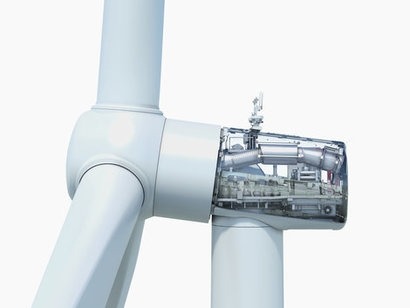
The company’s Onshore CEO Thomas Richterich launched three new turbine models for optimum performance at the WindEnergy Hamburg trade show this week. The turbines are intended for low wind, medium wind, and noise sensitive sites and share the same nacelle design thanks to a modular platform concept. Different controller settings and rotor diameters allow the new turbines to adapt to specific wind and site conditions. As the second generation of onshore direct drive technology was introduced two years ago with the Siemens SWT-3.3-130, all new models benefit from a short time-to-market.
The new low noise turbine – the SWT-3.3-130LN – and the new medium wind speed turbine – the SWT-3.6-130 - will go into serial production in early 2017. The low wind speed turbine - the SWT-3.15-142 - will follow in late 2017.
“Our new wind turbine portfolio is the result of an intelligent platform strategy that allows maximum flexibility” said Richterich, CEO Onshore of the Siemens Wind Power and Renewables Division. “Our customers benefit not only from benchmark setting performance in different wind classes, but also from the adaptability of our technology that meets nearly every site-, grid- and project specific requirement. Thanks to digitalisation, these turbines are open for further optimisation and individualisation.”
The SWT-3.3-130LN wind turbine is a low noise version of the SWT-3.3-130 with reduced rotor speed and improved aerodynamics. It is based on proven Siemens direct drive technology, and allows operation with a 104.9 db noise level at a wind speed of 6 m/s. The B63 blades of the SWT-3.3-130LN include new aerodynamic add-ons for optimized performance. In addition to the vortex generators applied on the blade backs, the trailing edges are equipped with Siemens DinoTails Next Generation.
Thanks to an uprated generator, the new SWT-3.6-130 is able to harvest an annual energy output (AEP) of up to 17 gigawatt hours (GWh) at 8.5 m/s. At the same wind speeds compared to the SWT-3.3-130 launched in 2014, this represents an improved AEP rating of 6 percent. With its high performance at IEC II sites, the SWT-3.6-130 sets a competitive benchmark for wind turbines designed to harvest maximum power outputs in environments with moderate wind conditions.
The new SWT-3.15-142 is the first Siemens Direct-Drive wind turbine dedicated for IEC Class III. It’s B69 rotor-blades are based on hybrid-carbon technology by LM Wind Power. With a rotor-diameter of 142 meters and tower configurations that allow hub heights up to 165 meters, new standards for annual energy yields are set: Even at wind speeds of only six meters per second, the machine harvests ten gigawatt hours of energy per year.
In other news, Siemens will implement a complete service concept to meet the maintenance needs of projects far offshore such as the Veja Mate offshore wind farm. The exact scope of supply includes the scheduled maintenance and upkeep of the OSS, the 67 transition pieces of the wind turbines, as well as the inspection of their underwater structures. A transition piece is the part that lies between a monopile foundation and the tower of an offshore wind turbine. Siemens will also build and operate an OCC in Hamburg, equipped with SCADA software provided by Veja Mate for the operational control of the wind farm. Siemens will be responsible for the entire offshore logistics, correcting faults on site and using EPCI contractor supplied spare parts and consumables during warranty.
For the turbines, Siemens will provide a highly advanced logistics concept, tailored specifically for far-shore projects, that uses both a helicopter and a specially designed, purpose-built service operation vessel (SOV). To ensure increased energy production this concept allows maintenance work to be carried out at almost all times irrespective of the weather conditions or wave height. The comprehensive service concept benefits from synergies resulting from close collaboration between different Siemens Divisions, their many years of experience in building, operating and maintaining complex offshore projects as well as the use of standard, in-house systems for planning and documenting the maintenance work and operating data of the offshore wind farm.
The Veja Mate offshore power plant is being built in the German waters of the North Sea, northwest of the island of Borkum at a distance of 115 kilometers off the East Frisian coast. The wind turbines in the SWT-6.0-154 series will be installed at ocean depths between 39 and 41 meters starting in January 2017. The 400 MW project will be connected via an offshore grid connection using high-voltage direct current (HVDC) technology from Siemens. Siemens handed the BorWin2 grid connection over to the operator in January 2015. This grid connection can transmit a total of just under 800 MW of clean wind energy, which is sufficient to supply power to approximately one million German homes. To date, Siemens has installed four HVDC grid connections and four wind power plants in the German waters of the North Sea alone; another DC-Link is ordered. Furthermore, Siemens will supply wind turbines to five offshore wind projects which are currently under construction in the German North and Baltic Sea.
For additional information:

